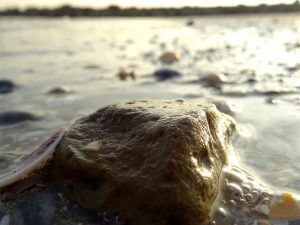Rachel Armstrong, Professor of Experimental Architecture and project coordinator of the Living Architecture (LIAR) research project, gives an update on the project and an exciting event showcasing the project’s development taking place in Venice.
The €3.2m LIAR project explores an extended conception of design by bringing together the sciences, design disciplines and the arts to explore the possibilities of “living” in the broadest sense of the term in the 3rd millennium.
LIAR will develop blocks able to extract resources from sunlight, waste water and air. The bricks are able to fit together and create ‘bioreactor walls’ which could then be incorporated in housing, public buildings and office spaces.
Each block will contain a microbial fuel cell, filled with programmable synthetic microorganisms developed by experts at UWE Bristol. Robotically activated, each chamber will contain a variety of microorganisms specifically chosen to clean water, reclaim phosphate, generate electricity and create new detergents. The living cells that will make up the wall will be able to sense their surroundings and respond to them through a series of digitally coordinated mechanisms.
LIAR is a collaboration of experts from the universities of the West of England (UWE Bristol), Trento, Italy, the Spanish National Research Council in Madrid; LIQUIFER Systems Group, Vienna, Austria and EXPLORA, Venice, Italy.
On Friday 14 October the LIAR consortium will host an event in Venice which will demonstrate a working brick and exhibit a ceramic model, which has been developed by LIQUIFER Systems Group, as a discussion point for the potential impact that future living bricks may have for architecture, design, ceramics and the arts.
This will be followed by a short round table of experts including Ioannis Ieropoulos from the University of West England and Juan Nogales from the Spanish National Research Council who will introduce the key technological advances.
Living bricks are part of the story of an alternative future for Venice, which owing to devastating changes in its relationship to rising water levels, is likely to be claimed by the sea. In 2008 we began to ask whether it was possible to turn the city’s fate around by equipping it with some of the properties of living things so that it may actively fight back against the elements in a struggle for survival like creatures do, and so, adapt to its changing conditions on ways that we’d normally associate with living systems.
Back in 2008 a model technology was explored as a possible platform for this transformation based on the chemistry and physical properties of dynamic droplets, with simple metabolisms. Potentially, such a system could initiate the construction of a protective limestone reef around the foundations of the city by biomineralizing Venice’s wooden foundations, which are under threat by the traffic from large cruise ships whose wakes suck the preserving salt water out from under the foundations, leaving the foundations exposed to the air, where they rot. With time, the bio concrete-stimulating droplets then would form a kind of protective kettle-limescale during these times and even build up a residue that could repair erosion of materials at the tidal zone in some specific locations.
Field studies to identify possible sites for testing the technology revealed that the natural marine wildlife was already carrying out a metabolically vigorous version of this process. This suggested that it might be possible to find ways of orchestrating a whole range of events between the biological systems in the lagoon, the chemical technology and the concrete-forming processes in the waterways to produce a synthetic platform, which was potentially programmable.

Living bricks are an exploration of that choreography, looking at how we might shape relationships between human habitation, technology and nature through a mutually beneficial relationship. While specific outcomes are not specifically directed towards the mineralization process at this stage, we are creating these prototypes so they can be directly interrogated by the Venice community, in the hope they will explore their functions and help us understand how such apparatuses may be useful in addressing real challenges within a city that is being, quite literally, digested by its circumstances.
So, living bricks are not a solution to a particular grand challenge, but a prototype that helps us all think differently about technology and architecture in challenging places. These prototypes address different approaches to optimizing the choreography between agents with complex relationships and may help us discover how we may differently address some of the pervasive problems of human habitation. For example, living bricks may help us understand how we may deal with our waste differently, provide clean water for everyone, or retrofit our buildings to increase their environmental value.
The Venice event takes place at Hotel Carlton on the Grand Canal, Santa Croce 578, 30135 – Venezia.
For details of the event on Friday 14 October please contact info@explora-biotech.com.
LIAR is funded by the European Union’s Horizon 2020 Research and Innovation Programme under Grant Agreement no 686585.
